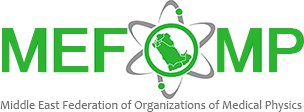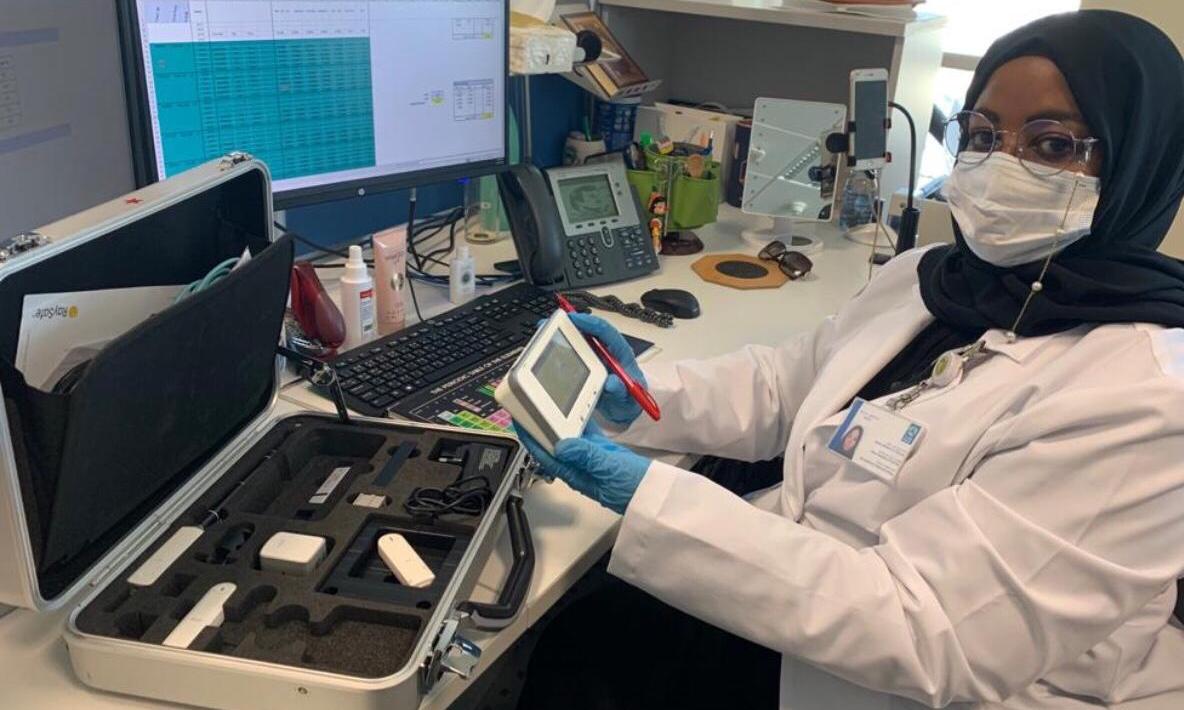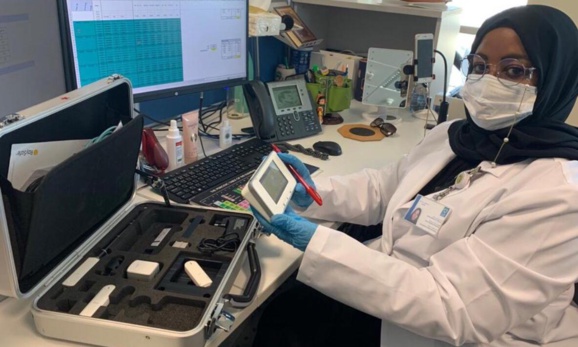Thirteen hospital were under Hamad Medical Corporation (HMC) umbrella, and as the COVID-19 crises started two additional hospitals were added to coup with the high number of corona patients.
At the beginning of the COVID-19 pandemic, Qatar government decided to reduce the number of staff working from office to 20% and the rest had to work from home using online remote access. Most of the work was performed from home, and only urgent activities that required physical presence were performed in the hospitals.
The medical physics team played a critical role since the beginning of the pandemic in ensuring that HMC staff are working in a safe environment while following protocols to prevent the spread of the virus to patients and their fellow staff across HMC.
The following briefly describes the activities related to all aspects of Medical Physics, Health Physics and Radiation Safety services offered in all Radiology and Nuclear Medicine Departments at HMC during the COVID-19 pandemic. These activities cover quality control (QC) measurements in new (acceptance testing) and existing (routing QC) radiological equipment, workplace monitoring, personal dosimetry (TLD), radioactive waste management, shielding surveys of x-ray facilities and QC testing of lead aprons.
1. Personal Dosimetry
For personal dosimetry, personnel monitoring is carried out using thermoluminescence dosimeter (TLD) badges to cover about 1400 radiation workers in HMC hospitals. Though the normal monitoring period is two months, due to the pandemic, it was decided to extend the use of the same TLD badges for four months (March-June) to avoid any possible spread of viruses between staff from a potentially contaminated TLD badge. In July of 2020, all the TLD badges were replaced to start the new monitoring cycle.
Replacement and reading of TLD badges were made with extreme caution to ensure that any potentially contaminated badges would not be a medium of virus spread.
Medical Physicists took all necessary precautions (using masks, gloves and alcohol sanitizers) in the collection of the old and delivery the new TLD badges to avoid potential contamination at both ends (TLD end users from the new TLD badges, and the monitoring service staff from the used TLD badges). Care to avoid contamination was taken during opening of the TLD badges and reading of the TLD cards. All used holders were stored for at least one week before reusing them and the workers were supplied with new holders.
2. Diagnostic radiology
Medical Physicists performed all essential QC tests for all x-ray units (CT scanners, fluoroscopy, mammography, general, mobile and dental X-ray units). Apart from routine QC testing in units that was past due and could not be postponed, acceptance QC tests had to be performed in all new radiological equipment delivered in HMC hospitals during the pandemic, some of which have been ordered due to pandemic and therefore had to be set in service as soon as possible. For the new equipment, several Medical Physicists had to come to the hospitals to carry out specified task and submit QC report. During the COVID-19 period, Medical Physicists had to perform acceptance QC tests for 3 CT scanners, 7 mobile X-ray, 1 dental CBCT, 2 General X-ray, 2 C-arm, 1 mini C-arm and 3 fluoroscopic units which were all used to equip COVID-19 designated HMC hospitals.
Moreover, working from home provided an ample time and opportunity for the Medical Physicist team assigned to prepare the new QC User Manual and related electronic QC forms, to progress and finalize their task. The QC User Manual is a document that describes in brief the basic methodology for performing all routine QC test performed in all radiological equipment using ionizing radiation, the quantities measured, the required equipment and the remedial levels. The new electronic QC forms (eQC forms) were re-designed from scratch (using Microsoft Excel) to be in line with the QC User Manual and it is expected to completely replace the old forms by the end of 2020.
Routine safety assessment and workplace monitoring of existing radiation facilities were postponed, except for those new facilities such as those that were opened to accommodate COVID-19 patients.
Two members of staff were assigned for QC testing of lead aprons (total of 2000 lead aprons in HMC). The task was carried out in isolated X-ray room with extra care to protect the staff collecting and testing the lead aprons.
3. Nuclear Medicine and PET/CT
During the COVID-19 pandemic, the medical physicists maintained all its normal services for the Nuclear Medicine departments, including the Nuclear Medicine equipment operating in HGH, as well as the PET/CT in NCCCR. Medical Physics services include a full range of QC tests performed to provide full evaluation of equipment performance, in order to ensure its optimal operation. The service covers PET/CT, SPECT/CT, SPECT, gamma cameras, as well as, dose calibrators, multi-channel analyzers (MCAs), etc. Moreover, the medical physicists assigned to nuclear medicine, drafted a new QC Manual (based on NEMA and IAEA guidelines) in order to set local Quality Control testing norms/references.
The radioactive waste management program in the Nuclear Medicine departments and the PET CT facility was continuously performed as planned with extra care to protect the staff collecting and storing the waste packages.
4. Training and licensing of radiation workers
In line with HMC actions to deal with the current COVID-19 situation, it was agreed with the Ministry of Municipality and Environment (the national regulator), to extend the validity of the Radiation Worker License (expired or due for renewal) automatically for 6 months, starting 1 April 2020, to enable HMC staff to continue practicing as usual with no need to apply for renewal.
In August of 2020, as the pandemic situation began to subside and stabilize, and the government started to ease gathering restrictions, the radiation protection training courses (which is a legal requirement for radiation workers in Qatar to renew their licenses) resumed in HMC. These courses were conducted following the current government guidelines on educational gatherings (organized entry by checking temperature, provision of hand sanitizers and wearing of face masks in addition to physical distancing).
5. Research and Publications
Working from home also gave Medical Physicists an opportunity to perform several activities related to research and publications. Given the fact that many of the normal activities were postponed or canceled, medical physicists had an ample time to revisit previous QC reports, which gave them chance to gather all data in an excel file for comprehensive analysis and for future use. Furthermore, previously started projects prior to the pandemic were finalized, amidst pandemic.
The following are the activities, which was started, continued and/or finalized during this time:
a. Publications in International journals and conferences
The Medical Physicists published eight papers in peer-reviewed international journals [1-8] and participated in five virtual meetings and conferences.
b. Research projects
c. Research tasks for the Medical physicists during COVID-19
Dr. Mohammad Hassan KHARITA
SG - MEFOMP
Assistant Executive Director - Radiation Safety
Hamad Medical Corporation
Qatar
6. References
At the beginning of the COVID-19 pandemic, Qatar government decided to reduce the number of staff working from office to 20% and the rest had to work from home using online remote access. Most of the work was performed from home, and only urgent activities that required physical presence were performed in the hospitals.
The medical physics team played a critical role since the beginning of the pandemic in ensuring that HMC staff are working in a safe environment while following protocols to prevent the spread of the virus to patients and their fellow staff across HMC.
The following briefly describes the activities related to all aspects of Medical Physics, Health Physics and Radiation Safety services offered in all Radiology and Nuclear Medicine Departments at HMC during the COVID-19 pandemic. These activities cover quality control (QC) measurements in new (acceptance testing) and existing (routing QC) radiological equipment, workplace monitoring, personal dosimetry (TLD), radioactive waste management, shielding surveys of x-ray facilities and QC testing of lead aprons.
1. Personal Dosimetry
For personal dosimetry, personnel monitoring is carried out using thermoluminescence dosimeter (TLD) badges to cover about 1400 radiation workers in HMC hospitals. Though the normal monitoring period is two months, due to the pandemic, it was decided to extend the use of the same TLD badges for four months (March-June) to avoid any possible spread of viruses between staff from a potentially contaminated TLD badge. In July of 2020, all the TLD badges were replaced to start the new monitoring cycle.
Replacement and reading of TLD badges were made with extreme caution to ensure that any potentially contaminated badges would not be a medium of virus spread.
Medical Physicists took all necessary precautions (using masks, gloves and alcohol sanitizers) in the collection of the old and delivery the new TLD badges to avoid potential contamination at both ends (TLD end users from the new TLD badges, and the monitoring service staff from the used TLD badges). Care to avoid contamination was taken during opening of the TLD badges and reading of the TLD cards. All used holders were stored for at least one week before reusing them and the workers were supplied with new holders.
2. Diagnostic radiology
Medical Physicists performed all essential QC tests for all x-ray units (CT scanners, fluoroscopy, mammography, general, mobile and dental X-ray units). Apart from routine QC testing in units that was past due and could not be postponed, acceptance QC tests had to be performed in all new radiological equipment delivered in HMC hospitals during the pandemic, some of which have been ordered due to pandemic and therefore had to be set in service as soon as possible. For the new equipment, several Medical Physicists had to come to the hospitals to carry out specified task and submit QC report. During the COVID-19 period, Medical Physicists had to perform acceptance QC tests for 3 CT scanners, 7 mobile X-ray, 1 dental CBCT, 2 General X-ray, 2 C-arm, 1 mini C-arm and 3 fluoroscopic units which were all used to equip COVID-19 designated HMC hospitals.
Moreover, working from home provided an ample time and opportunity for the Medical Physicist team assigned to prepare the new QC User Manual and related electronic QC forms, to progress and finalize their task. The QC User Manual is a document that describes in brief the basic methodology for performing all routine QC test performed in all radiological equipment using ionizing radiation, the quantities measured, the required equipment and the remedial levels. The new electronic QC forms (eQC forms) were re-designed from scratch (using Microsoft Excel) to be in line with the QC User Manual and it is expected to completely replace the old forms by the end of 2020.
Routine safety assessment and workplace monitoring of existing radiation facilities were postponed, except for those new facilities such as those that were opened to accommodate COVID-19 patients.
Two members of staff were assigned for QC testing of lead aprons (total of 2000 lead aprons in HMC). The task was carried out in isolated X-ray room with extra care to protect the staff collecting and testing the lead aprons.
3. Nuclear Medicine and PET/CT
During the COVID-19 pandemic, the medical physicists maintained all its normal services for the Nuclear Medicine departments, including the Nuclear Medicine equipment operating in HGH, as well as the PET/CT in NCCCR. Medical Physics services include a full range of QC tests performed to provide full evaluation of equipment performance, in order to ensure its optimal operation. The service covers PET/CT, SPECT/CT, SPECT, gamma cameras, as well as, dose calibrators, multi-channel analyzers (MCAs), etc. Moreover, the medical physicists assigned to nuclear medicine, drafted a new QC Manual (based on NEMA and IAEA guidelines) in order to set local Quality Control testing norms/references.
The radioactive waste management program in the Nuclear Medicine departments and the PET CT facility was continuously performed as planned with extra care to protect the staff collecting and storing the waste packages.
4. Training and licensing of radiation workers
In line with HMC actions to deal with the current COVID-19 situation, it was agreed with the Ministry of Municipality and Environment (the national regulator), to extend the validity of the Radiation Worker License (expired or due for renewal) automatically for 6 months, starting 1 April 2020, to enable HMC staff to continue practicing as usual with no need to apply for renewal.
In August of 2020, as the pandemic situation began to subside and stabilize, and the government started to ease gathering restrictions, the radiation protection training courses (which is a legal requirement for radiation workers in Qatar to renew their licenses) resumed in HMC. These courses were conducted following the current government guidelines on educational gatherings (organized entry by checking temperature, provision of hand sanitizers and wearing of face masks in addition to physical distancing).
5. Research and Publications
Working from home also gave Medical Physicists an opportunity to perform several activities related to research and publications. Given the fact that many of the normal activities were postponed or canceled, medical physicists had an ample time to revisit previous QC reports, which gave them chance to gather all data in an excel file for comprehensive analysis and for future use. Furthermore, previously started projects prior to the pandemic were finalized, amidst pandemic.
The following are the activities, which was started, continued and/or finalized during this time:
a. Publications in International journals and conferences
The Medical Physicists published eight papers in peer-reviewed international journals [1-8] and participated in five virtual meetings and conferences.
b. Research projects
- Participated in a new IAEA Study lead by the Radiation Protection of Patients Unit, on the use of CT in patients with COVID-19 pneumonia.
- Personalized assessment and monitoring of organ-level cancer risks and radiation dose in nuclear medicine and radiological examinations. Funded by QNRF.
- Establishment of Clinical Diagnostic Reference Levels for Qatar. Funded by Hamad Medical Research Center (MRC).
- Dose reduction for staff during F18-FDG PET/CT imaging. Funded by MRC.
- Establishment of Internal Dosimetry Services. National IAEA Technical Cooperation project 2020-2021.
- The implementation of a project on Quality audit of monitors used in acquisition and diagnostic workstation monitors across HMC (170 monitors).
c. Research tasks for the Medical physicists during COVID-19
- Radiation safety management for radioactive waste in HMC.
- Quality control program in medical ultrasound in HMC.
- Evolution of Quality Control Service of radiological equipment in HMC since 2005.
- Statistical analysis of the QC tests findings since 2015 for:
- general and mobile X-ray systems
- CT equipment in HMC.
- dental X-ray units
- mammography systems.
- Radiation exposure of patients from recurrent radiological imaging procedures in HMC.
- Analysis of occupational doses of monitored staff since the start of the TLD service in HMC.
Dr. Mohammad Hassan KHARITA
SG - MEFOMP
Assistant Executive Director - Radiation Safety
Hamad Medical Corporation
Qatar
6. References
- Mohammad Hassan Kharita, Huda Al-Naemi, Chiara Arru, Ahmed Jenaid Omar, Antar Aly, Ioannis Tsalafoutas, Shady Alkhazzam, Ramandeep Singh, Mannudeep K. Kalra. Relation between Age and CT Radiation Doses: Dose Trends in 705 Pediatric Head CT. European Journal of Radiology 2020; 130 https://doi.org/10.1016/j.ejrad.2020.109138
- Shivam Rastogi, Ramandeep Singh, Riddhi Borse, Petra Valkovic Zujic, Doris Segota, Ana Diklic, Slaven Jurkovic, Antar Ali, Hassan Mohammed Kharita, Huda M. Al-Naemi, et al. Use of Multiphase CT Protocols in 18 Countries: Appropriateness and Radiation Doses. [published online ahead of print, 2020 Jan 27]. Canadian Association of Radiologists Journal 1-7, 2020. https://doi.org/10.1177/0846537119888390
- Huda Al Naemi, Antar Aly, Mohamad Hassan Kharita, Shatha Al Hilli, Amal Al Obadli, Ramandeep Singh, Madan M. Rehani,Mannudeep K. Kalra. Multiphase abdomen-pelvis CT in women of childbearing potential (WOCBP): Justification and radiation dose. Medicine 2020; 99(4).
https://doi.org/10.1097/MD.0000000000018485 - Huda Al Naemi, Antar Aly, Ahmed J.Omar, Amal AlObadli, Olivera Ciraj-Bjelac, Mohamad Hassan Kharita and Madan M. Rehani.Evaluation of radiation dose for patients undergoing mammography in Qatar. Radiation Protection Dosimetry, 2020;189(3):354-361. https://doi.org/10.1093/rpd/ncaa049
- Anand K. Narayan, Huda Al-Naemi, Antar Aly, Mohammad Hassan Kharita, Ruhani Doda Khera, Mohamad Hajaj, Madan M. Rehani.Breast Cancer Detection in Qatar: Evaluation of Mammography Image Quality Using A Standardized Assessment Tool Eur J Breast Health 2020; 16(2): 124-128. https://doi.org/10.5152/ejbh.2020.5115
- Ioannis Tsalafoutas, Mohammed Hassan Kharita, Huda Al Naemi, Mannudeep Kalra: Radiation Dose Monitoring in Computed Tomography: Status, Options and Limitations. European Jornal of medical Physics - Physica Medica. September, 2020 DOI:https://doi.org/10.1016/j.ejmp.2020.08.020
- Mohammad Hassan Kharita, Huda Al Naemi, Vishwanatha Kini, Shady Alkhazzam, Madan M. Rehani. Development of image quality related reference doses called acceptable quality doses: (AQD) in paediatric CT exams in Qatar. Accepted for publication in European Radiology (September 2020).
- Huda AlNaemi, Virginia Tsapaki, Ahmed J. Omar, Maryam AlKuwari, Amal Al Obadli, Shady Alkhazzam, Antar Aly, Mohammad Hassan Kharita. Towards establishment of diagnostic reference levels based on clinical indication in the state of Qatar. Submitted to European Journal of Radiology July 2020, Under consideration for acceptance, minor revision (Aug. 2020).




 Officers
Officers













